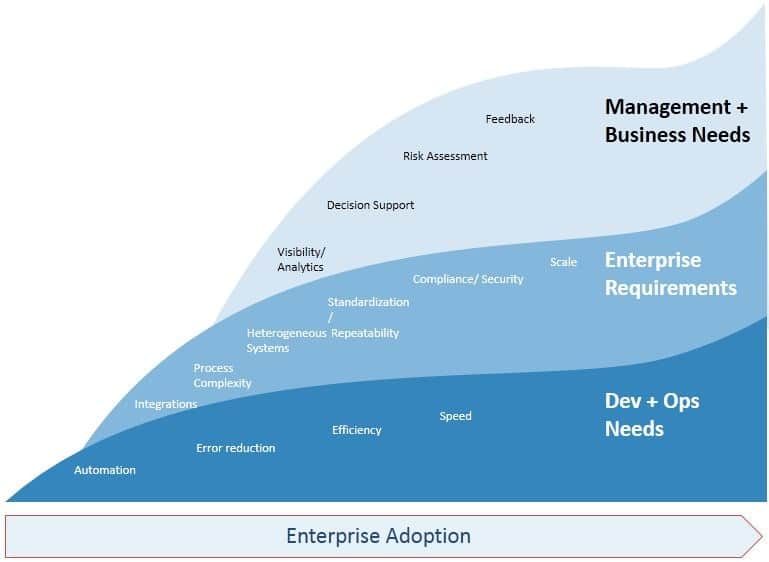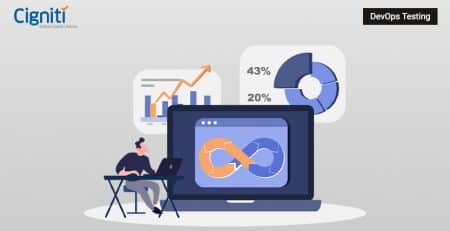How to successfully take on the DevOps Adoption Wave within QA?
Let us begin with acknowledging the fact that riding the DevOps Adoption Wave requires you to have a team of ‘rockstars’ who are ready to take that leap of faith with you. They are ready to face all troubles – such as hitting the wall of scalability, but in the end, deliver data-driven, continuous improvement that helps enterprises scale up to DevOps.
DevOps has been questioned on various grounds such as its efficiency, its result-oriented approach, for its team transformation techniques, and ultimately software development process. There has been experimentation around this approach, which continues to happen even today to ensure that it brings business value. DevOps has also been accepted and adopted across enterprises and development teams as it boosts collaboration, standardizes environment, brings automation, and helps provide constant feedback.
DevOps enables teams to collaborate better and gain faster consensus with closer collaboration between Dev, Test and Ops teams. This boosts innovation in development, testing, and deployment practices. It further boosts agility by enabling enterprises to ‘try fast, fail fast and recover fast’. DevOps encourages faster testing and deployments with standardization of environments.
In a way, less time is consumed on debugging environment issues and there is a lot of focus on innovation and achieving business goals. This results in faster time-to-market with automated delivery pipeline, and overall, the agility for A/B testing and testing in production through automated builds and deployment improves. Most importantly, DevOps facilitates continuous customer feedback through production monitoring on user experience and reviews, with Performance Monitoring.
What is the DevOps Transformation Journey?
As experts and industry analysts acknowledge, DevOps is not merely a process for delivering applications and software, it entails transformation at an organizational level. DevOps Transformation journey involves all the functions, which ultimately results in a cultural transformation across the workforce.
It involves various aspects such as cost of maintenance, technology innovation, and organization change management involving people, process, and systems. DevOps approach emphasizes on effective adoption of tools and processes for Continuous Integration and Continuous Delivery.
Likewise, there could be requirements related to on-demand test environments, end-to-end automation and test coverage, tools for automation, and process standardization. While DevOps encourages agility, it is also process driven, where every activity needs to be monitored and tracked via dashboards and metrics.
In terms of RoI, DevOps has a lot to offer. Some of the key highlights are building reliability, uninterrupted service delivery, and quality engineering approach for early testing. Continuous Testing results in constant feedback, and eventually stabilizes the automation tasks. It helps build quality check gates, and enables choice of best suited tools for any specific requirements.
DevOps helps teams to build cost-effective frameworks to deliver faster and ensure quality. It clears communication channels, encourages more feedback, and facilitates transparency for effective decision making.
Development teams break down their functions into silos and collaborate to deliver cohesively. This brings business agility and creates a much-needed environment for mutual collaboration, communication, and integration even at a globally collocated team level. In a DevOps set-up, role-specific boundaries get diluted and the entire team works towards quality and timelines for deliverables.
What does DevOps Adoption Wave involve?
DevOps has taken a major jump and got serious attention since 2016, due to its ability to offer business value in terms of deliverables for organizations. People, Processes, Automation, and Data are some of the key components in the DevOps Adoption phase.
Gartner in one of its reports had summarized that ‘DevOps initiatives include a range of technologies and methodologies spanning the software delivery process. I&O leaders must recognize the readiness and abilities of DevOps technologies to ensure that their DevOps initiatives accelerate time to market and the delivery of business value.’
The approach holds together many stakes and stakeholders in its efforts to bring about organizational transformation and accelerates delivery of software and software applications. It has to be a smooth sailing ride to derive the estimated RoI and keep it coming on a constant basis. There is no scope for silos and independent operations in a DevOps environment.
It invariably involves people, as skilled resources are needed for taking the development and automation process ahead. The process begins at the conceptual level and then is translated into standardized automation activities for execution and delivery. In this way, traditional organizations transform into modern enterprises by becoming increasingly agile and adaptable.
Automation is the key driver in DevOps, where there is no scope for manual interface. It has been estimated that with adoption of new processes, teams are able to increase their productivity by almost 80%. Continuous Integration and Delivery help solve most of the issues and enable constant feedback with Continuous Testing.
This enables early and frequent testing. Hence, Continuous communication becomes another key driver in the DevOps Adoption process.
Most importantly, DevOps uses data to drive the improvement cycle at scale and helps simplify the application architecture to accelerate the development process. It involves major reshuffling of roles, comprising all the parties with intense monitoring formats.
Another key aspect is building compliancy into the project pipeline, which takes deployment beyond Development and Testing. Building standardized processes for monitoring quality is one of the key highlights of adopting DevOps. That said, it is a challenge for organizations to make this happen and get a buy-in from every unit within the system.
That’s the very reason that DevOps addresses People – Processes – Systems as a whole, not in silos. It addresses three key aspects in its stride – Management and Business needs, Enterprise requirements, and Dev+Ops needs.
We can certainly say that DevOps is a percolation process, which evolves from bottom to top and in reverse. Every level of adoption generates needs that must be addressed. A seamless adoption can be expected only after every aspect is considered and acknowledged in its totality, by keeping the larger picture into perspective.
Once these factors are considered, organizations would be able to validate the results from the approach and keep them coming on a consistent basis. RoI is a tactical term, but the benefits must be seen at every level of adoption within the system.
In Conclusion
Whether it’s Artificial Intelligence, Virtual Reality, Machine Learning, or any other smart technology, businesses need to adopt these new ways to bring in the appeal and recognition for their brand. DevOps as an approach has been enabling enterprises to adopt these new ways by gradually validating its impact, but at a constant pace. Hence, for now, it will continue to bring relevance in application for enterprises that want to stay competent and innovative.
At Cigniti, we standardize efforts and ensure accelerated time to market with DevOps Testing.
We recently conducted a Webinar on the topic ‘Accelerate Digital Transformation with DevOps’. View the recording here.






Leave a Reply